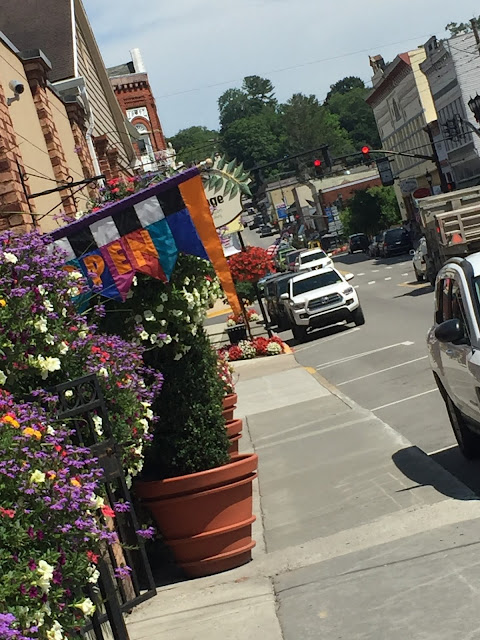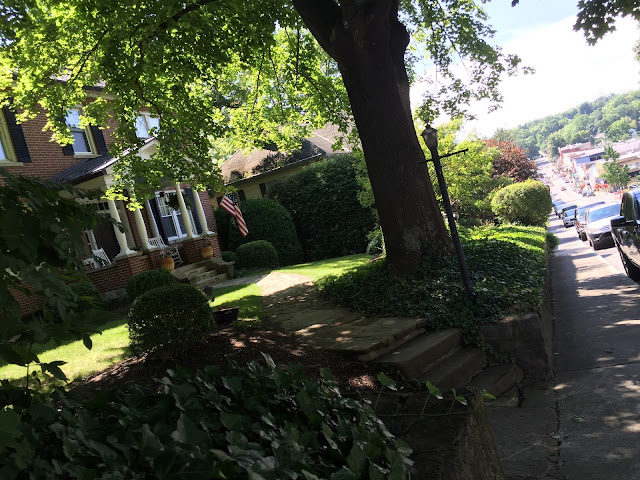Early in the summer, I excitedly signed my family up to take part in a summer nature exchange. We began collecting, pressing, and drying a sampling of assorted area wildflowers. I'm somewhat obsessive about incorporating as much learning as possible into our daily activities. (We homeschool, remember?) But this time I was in desperate need of some inspiration in order to do something a little bit different; to make this project more interesting; to give it a theme. So we stopped by our local visitor's center, picked up some brochures about our region planning to send them on to our nature exchange pals in Kansas along with some crafty items we created. One of these pamphlets lays out the saga of a little-known battle that took place right here in our little ole' town. Ah-ha! I had found my angle.
(Before you read any further, my apologies to all you history and nature experts. I'm not in your club. My goal is to engage our children to look around, to be observant, and to be curious about their world. I'm doing the best I can.)
Lewisburg, West (by God) Virginia. Greenbrier County. Washington Street. Our house is situated right on the battleground of The Battle of Lewisburg which took place for all of one hour on May 23, 1862. Let me tell you a tale of yesterday framed by the natural beauty of today's Greenbrier Valley.
In 1862 Lewisburg, Virginia was a quiet, sleepy, little town with a population of 800 people, consisting mainly of Southern sympathizers. (I believe the population today is only around 4000.) On May 21, Union officer Colonel George Crook and his 3rd Provisional Ohio Brigade set up camp with the knowledge that rebel troops were going to be moving into Lewisburg. Colonel Crook's claim to fame was that he captured the Apache Chief Geronimo. His battalion, made up of about 1400 troops from Ohio, was encamped on top of a hill to the west of the city.
Today this area is home to our beautiful Greenbrier County Public Library. A well-marked path leads from the library all the way to our new elementary school lined with White Heath Aster, Honey Suckle, White Clover, Fleabane, various grasses, and yummy blackberries all along the way. The Union had a great vantage point.

He placed his sentry about three miles to the east to guard the bridge at Caldwell and to watch for the approaching enemy.
The bridge spans our lovely Greenbrier River which is still at a high level due to our horrendous recent flooding. Its banks display American Chestnut trees, Red Maples, Purple Aster, and abundant Queen Anne's Lace. This stately historic home pictured below has been flooded numerous times and now is once again waterlogged.
One of our favorite activities has always been riding bikes on the Greenbrier River Trail which we enter at this location. I think my favorite tree leaf here belongs to the American Tulip also known as the Tulip Poplar. Today we ventured onto the trail for a little look-see. We didn't get very far before confronted with this jarring abyss.
But Crook's guards couldn't compete with the approaching Confederates. In the severely early hours of May 23, the rebels led by Brigadier General Henry Heth seized the bridge, captured the Union sentry, and trudged into Lewisburg. This force, made up of about 2300 Virginians, was confident and sure of victory. They had yet to experience defeat, even boasting how they were going to visit the ladies of Lewisburg once they chased the Yankees out of town. They thought that they were going to stage a surprise attack, but luckily Colonel Crook was alerted. Although this battle was the first for Crook's troops, they were up for the task. They were out-manned and out-armed, yet they were ready to take on the rebel troops.
One section of the rebel Virginia troops set up camp to the east of town along what is now Dwyer Lane.
We spend lots of time at this spot. It is now home to three baseball fields, one football field, a track, playground, skate park, and trees just waiting to be climbed. This site is full of Pitch Pine, Virginia Pine, Hemlock, and Sycamore trees. Years ago my now adult children loved to hang out in these trees. At that moment in time, I would have never imagined that we'd have two more children scrambling up these branches.
More Virginia infantry made their way to the right to hold in a field behind what is now the West Virginia School of Osteopathic Medicine. Here they waited for their orders.
WVSOM is one of the leading medical schools in our nation. It's original building housed the Greenbrier Military School from 1812 to 1972. I wonder if any of these White Oak and Black Locust trees had grandparents standing here back then. In 1974, this osteopathic school began with a class of 36 students. Today the school is a thriving part of our community and has an enrollment of approximately 800 students. The clock tower shown below is a focal point of a brand new student union building.
Finally, the 8th Virginia Calvary and Artillery (canons) were stationed in another field to the left overlooking the town.
This property is now the lovely backyard of The General Lewis Inn, dating back to 1834. It has 25 rooms and specializes in weddings and special events. (And it's three houses up the street from our house.)
At 5:00 a.m. General Heth was ready to give it to those damn yankees. He started the bombardment but misjudged the range of fire. Instead of reaching the Union camp, a canon ball fell short killing one of his own men and hitting the John Wesley Methodist Church.
This lovely historic church is still very active today. I know because it is right behind my house!
The Confederates finally figured out the shooting range and began an all out attack. Union troops quickly assembled at the bottom of Foster Street and pushed their way towards the rebels who had so rudely awakened them.
The lawn of Carnegie Hall occupies this location. It is the site of various performances, educational activities, and outdoor concerts. An unbelievably gorgeous Gingko Tree is its centerpiece. We're mesmerized by this tree with its fan-shaped leaves especially in the fall. Amazingly, all the leaves drop over the span of about one day creating a ground cover of glimmering gold.
 |
| Our lovely daughter and her sweet friends enjoying an evening on the lawn at an Ivy Terrace concert. Aren't they adorable? |
Another group of Cook's men assembled at the Greenbrier County Courthouse. They advanced uphill to meet up with the right side of the Virginian forces. Although inexperienced, the Union soldiers fought like veterans and the rebels began "falling like ten pins in a bowling alley."
Our courthouse has been in constant use since it was built. My lawyer husband is a regular there.
The 36th and the 44th Ohio troops were charging up the hill on the left and on the right and now the the 2nd (West) Virginia Union Cavalry joined them making its way right up the center of Lewisburg. They were boldly heading up Washington Street straight into the hub of the Confederates.
Washington Street is the heart of our downtown. Actually, it IS our downtown brimming with trendy shops and upscale restaurants. I adore the flowers outside of Del Sol. Our local merchants take pride in creating a delightful street overflowing with curb appeal.
When Colonel Crook's men reached the crest of the hill where the General Lewis Inn stands, they moved in and overran the artillery. They then crossed over to a nearby field and opened fire on the Ohio battalion. The rebels ran despite strong efforts from some of their officers to rally the troops.
This field is now a quiet little neighborhood. The homes are modest, but all are landscaped with well cared for lawns and gardens. We walk this neighborhood daily. Hey...that's our neighborhood!
Heth's casualties were far greater than those of Crook's. 80 of his soldiers were dead, 100 were wounded, and 157 were taken prisoner. The Union fared much better. 13 were killed, 53 were wounded, and 7 were missing. Colonel Crook wouldn't allow the rebel sympathizing citizens of Lewisburg to bury the dead Confederate soldiers or have any burial ceremonies. The bodies were placed in a trench in the churchyard of the Old Stone Church.
This historic church and its graveyard are poplar attractions. In the fall, it is haunted by ghost tours led by guides full of tantalizing tales about its inhabitants. It is framed by huge Hemlock trees, Eastern Red Cedars, and White Spruce.
At some time after the war, these Confederate remains were moved to the site of the Union encampment and placed in a cross shaped mound on top of the hill.
95 unidentified Confederate soldiers lie here today under huge Pine, Locust, and Maple trees. It's a lovely, peaceful setting.
The wounded from both camps were cared for in several of Lewisburg's public buildings which were used as hospitals. With the battle over, every soldier was kindly nursed no matter where their loyalties lay.
Three of these buildings are the John Wesley Methodist Church (the one the canon ball hit), Old Stone Presbyterian Church (with the dead soldiers beside it), and the old Greenbrier County Library. This building served as our county's library until 2007 when our present beautiful library opened.
So, this is the end of the story about an insignificant Civil War battle which took place in a tranquil Southern town that is surrounded by fairly typical natural beauty. Yet, when I take the time to look around, I realize that it's all the little, seemingly simple things that make where we live and what we learn about all extremely significant.
Our home stands in the shade of a giant Sugar Maple only steps away from the very spot of this Union victory. Oh, what stories this old tree could tell...




























No comments:
Post a Comment